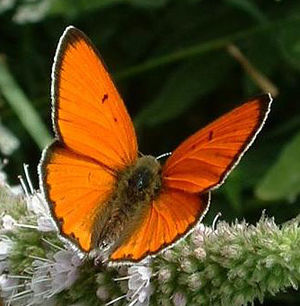Glossata
| Glossata | ||||||||||
|---|---|---|---|---|---|---|---|---|---|---|

Great fire butterfly ( Lycaena dispar ) |
||||||||||
| Systematics | ||||||||||
|
||||||||||
| Scientific name | ||||||||||
| Glossata | ||||||||||
| Fabricius , 1775 |
The glossata are the main subordinate group of butterflies (Lepidoptera). With the exception of three primeval groups - with a total of over 100 known species - they contain all representatives of this insect order.
features
Adults
The glossata differ greatly from the other three other groups that remained originally, which are placed in their own subordinate groups ( primeval moths , agathiphaga and heterobathmia ). The mandibles are severely receded, and the maxilla lacks one of the sclerotized chewings , the lacinia . In some families, such as B. the deer moths (Eriocraniidae), the regressed Lancinia is still recognizable on the base of the inside of the maxilla on a folded membrane . In these species the lacinia muscle extending from the head is also present. The second chew of the maxilla, the galea , is transformed into a proboscis consisting of two flexible half-tubes that are connected with folded sutures. The suction tube with which liquid food can be absorbed is formed between the two tubes. The proboscis is wrapped in a spiral shape under the head in the rest position. In some families, however, this achievement has stunted and regressed. The prelabium , the distal (away from the body) part of the labium on the hypopharynx (appendix of the head capsule) is only developed in the less developed families and is a narrow flap. The infrabuccal pocket (a sack-shaped pocket on the underside of the oral cavity) is absent at the base of the hypopharynx . The cerebrum (paired, lobed part of the brain ) is connected to the neurons below the esophageal canal called the suboesophageal ganglion .
Caterpillars
The lower part of the clypeus (frontal plate) in the caterpillars is hairless and not clearly delineated. However, this is very much the case with the primitive families of the Glossata, which is why this characteristic cannot yet be clearly assigned to subordination. Well-developed mandibles are also present in these caterpillars (e.g. flying moths and Acanthopteroctetidae ). The caterpillars have well-developed spinning glands at the apex (tip) of the prelabium on the hypopharynx .
Systematics
The relationships within the glossata have not yet been fully clarified. A phylogenetic study by Nielsen & Kristensen (1996) on the basis of 46 characteristics revealed the following relationships:
| Glossata |
|
||||||||||||||||||||||||||||||
|
|
Molecular phylogenetic study (March 2013)
A large-scale study published in March 2013 examined the order of butterflies for kinship relationships. In this study Acanthopteroctetidae and Neopseustidae form a common group. This group is classified as a sister group of Heteroneura . Exoporia is classified as a sister group of Lophocoronidae .
The cladogram for glossata looks like this:
| Glossata |
|
||||||||||||||||||||||||||||||
|
|
supporting documents
Individual evidence
- ↑ a b c d e f N. P. Kristensen: Studies on the morphology and systematics of primitive Lepidoptera (Insecta) . In: Steenstrupia . tape 10 , 1984, pp. 141-191 .
- ^ NP Kristensen: The anatomy of the head and the alimentary canal of adult Eriocraniidae . In: Entomologiske Meddelelser . tape 36 , 1968, pp. 239-315 .
- ↑ Niels P. Kristensen: Lepidoptera, moths and butterflies . In: Maximilian Fischer (Ed.): Handbook of Zoology . 1st edition. tape 4 - Arthropoda: Insecta , volume 35. de Gruyter, Berlin / New York 1998, ISBN 3-11-015704-7 (English).
- ↑ Jerome C. Regier, Charles Mitter a. a .: A Large-Scale, Higher-Level, Molecular Phylogenetic Study of the Insect Order Lepidoptera (Moths and Butterflies). In: PLoS ONE. 8, 2013, p. E58568, doi : 10.1371 / journal.pone.0058568 .
literature
- NP Kristensen , AW Skalski: Phylogeny and paleontology . In: NP Kristensen (Ed.): Lepidoptera: Moths and Butterflies. 1. Evolution, Systematics, and Biogeography. Handbook of Zoology Vol. IV, Part 35 . De Gruyter, Berlin and New York 1999, p. 7-25 .
- BM Wiegmann, JC Regier, C. Mitter: Combined molecular and morphological evidence on the phylogeny of the earliest lepidopteran lineages . In: Zoologica Scripta . tape 31 , 2002, p. 67-81 .